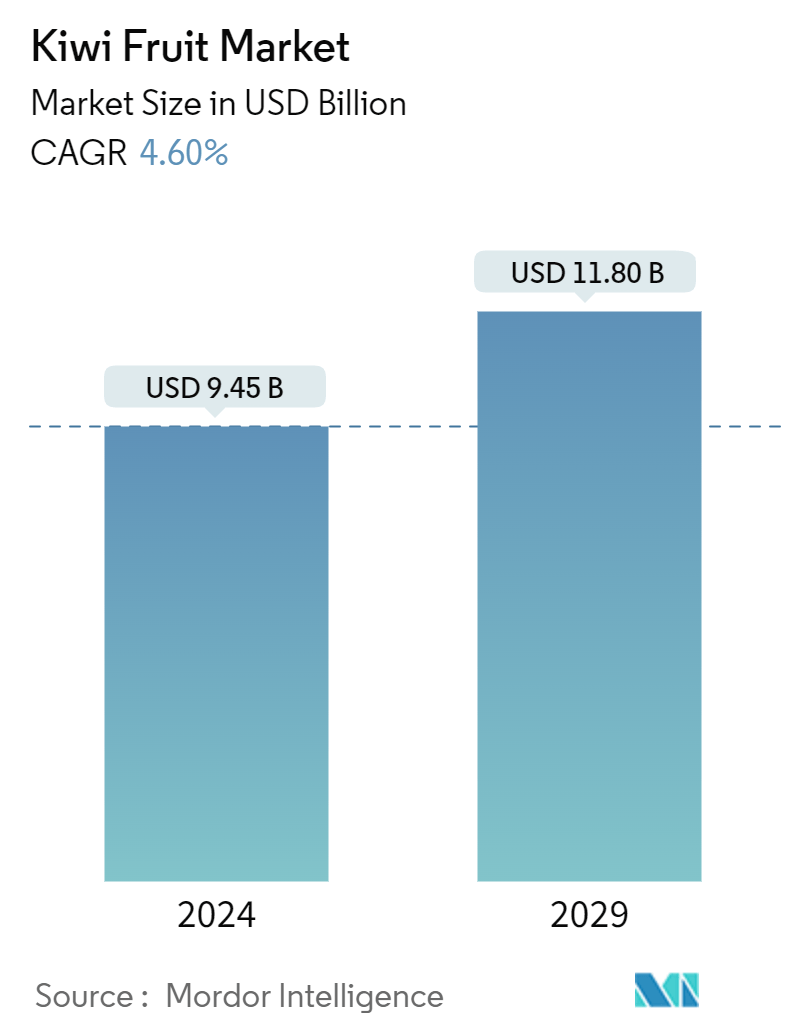Market Size of Kiwi Fruit Industry

| Study Period | 2019 - 2029 |
| Base Year For Estimation | 2023 |
| Forecast Data Period | 2024 - 2029 |
| Market Size (2024) | USD 9.45 Billion |
| Market Size (2029) | USD 11.80 Billion |
| CAGR (2024 - 2029) | 4.60 % |
Kiwi Fruit Market Analysis
The Kiwi Fruit Market size is estimated at USD 9.45 billion in 2024, and is expected to reach USD 11.80 billion by 2029, growing at a CAGR of 4.60% during the forecast period (2024-2029).
Kiwi fruit, a vitamin-laden fruit originating in the Chinese Himalayas, is now widely produced and cultivated globally. It is grown in various countries, including China, New Zealand, Greece, Italy, and France. The FAO stated that in 2022, China emerged as the primary producer of Kiwi, with a substantial production volume of 2.4 million metric tons. Following closely behind, New Zealand ranked second with a 0.6 million metric tons production volume. Italy, Greece, and Chile also secured positions within the top five for their impressive Kiwi production yields. New Zealand is the world's top exporter of Kiwi, holding a significant 41.7% value share of the global market in 2023. According to the ITC Trade Map, New Zealand exported 586,710.6 metric tons of Kiwi worth USD 1,700,396.0 thousand, leading the way followed by Italy with 304,757.0 metric tons valued at USD 666,450.0 thousand in 2023. The increasing popularity and demand for Kiwi can be largely credited to the growing emphasis on health and well-being, as these fruits are rich in vital nutrients such as potassium, magnesium, copper, manganese, iron, and vitamin B6. Kiwi is highly valued in the Food & Beverages industry for its versatility, as it is used in various products such as jams, sauces, purees, salads, dessert toppings, frostings, juices, and smoothies. Its wide range of applications makes Kiwi a crucial component in many dishes.
Kiwi Fruit Industry Segmentation
Kiwifruit, also known as Chinese gooseberry, is an edible berry of several species of woody vines in the genus Actinidia. The report contains an analysis of the various parameters of the kiwi fruit market. The study considers the commercial kiwi fruit as a commodity and only fresh fruit is considered for the study.
The kiwi fruit market is segmented by geography (North America, Europe, Asia-Pacific, South America, and Middle East & Africa). The report includes production (volume), consumption (volume and value), import (volume and value), export (volume and value), and price trend analysis of the kiwi fruit markets across the segments. The report offers market estimation and forecast in value (USD) and volume (metric tons) for the above-mentioned segments.
| North America | |
| United States | |
| Canada |
| Europe | |
| Spain | |
| Germany | |
| United Kingdom | |
| Italy | |
| Greece | |
| France | |
| Netherlands |
| Asia-Pacific | |
| China | |
| New Zealand | |
| India | |
| Australia | |
| Japan | |
| South Korea |
| South America | |
| Brazil | |
| Argentina |
| Middle East & Africa | |
| South Africa | |
| Egypt |
Kiwi Fruit Market Size Summary
The kiwi fruit market is experiencing significant growth, driven by its increasing global popularity and demand. Originating from the Chinese Himalayas, kiwi is now cultivated in various countries, with China and New Zealand leading in production and export. The fruit's rich nutrient profile, including potassium, magnesium, and vitamins, aligns with the growing consumer focus on health and well-being. This has made kiwi a sought-after ingredient in the food and beverages industry, where it is used in a variety of products such as jams, sauces, and smoothies. The market is expected to continue expanding, supported by the fruit's versatility and the rising consumer preference for natural, nutrient-dense foods.
China plays a pivotal role in the global kiwi fruit industry, both in terms of production volume and variety. The country's adoption of modern agricultural techniques and sustainable farming practices has enhanced its kiwi production capabilities, making it a key player in the market. Regions like Shaanxi and Sichuan are notable production hubs, contributing to China's status as a leading producer. The shift towards organic and environmentally friendly farming methods has further bolstered production, aligning with global trends towards health and sustainability. As a result, the kiwi fruit market is poised for continued growth, with China at the forefront of this expansion.
Kiwi Fruit Market Size - Table of Contents
-
1. MARKET DYNAMICS
-
1.1 Market Overview
-
1.2 Market Drivers
-
1.2.1 Increasing Health Consciousness Among Consumers
-
1.2.2 Application Of Kiwi Extract In Food Manufacturing
-
-
1.3 Market Restraints
-
1.3.1 Major Pest and Disease Outbreaks in Kiwi Production
-
-
1.4 Value Chain Analysis
-
-
2. MARKET SEGMENTATION (Production Analysis by Volume, Consumption Analysis by Volume and Value, Import Analysis by Volume and Value, Export Analysis by Volume and Value, and Price Trend Analysis)
-
2.1 North America
-
2.1.1 United States
-
2.1.2 Canada
-
-
2.2 Europe
-
2.2.1 Spain
-
2.2.2 Germany
-
2.2.3 United Kingdom
-
2.2.4 Italy
-
2.2.5 Greece
-
2.2.6 France
-
2.2.7 Netherlands
-
-
2.3 Asia-Pacific
-
2.3.1 China
-
2.3.2 New Zealand
-
2.3.3 India
-
2.3.4 Australia
-
2.3.5 Japan
-
2.3.6 South Korea
-
-
2.4 South America
-
2.4.1 Brazil
-
2.4.2 Argentina
-
-
2.5 Middle East & Africa
-
2.5.1 South Africa
-
2.5.2 Egypt
-
-
Kiwi Fruit Market Size FAQs
How big is the Kiwi Fruit Market?
The Kiwi Fruit Market size is expected to reach USD 9.45 billion in 2024 and grow at a CAGR of 4.60% to reach USD 11.80 billion by 2029.
What is the current Kiwi Fruit Market size?
In 2024, the Kiwi Fruit Market size is expected to reach USD 9.45 billion.

